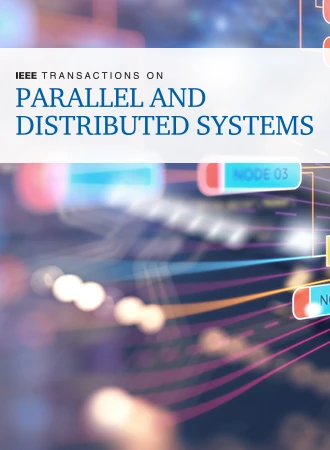Acceleration of Multi-Body Molecular Dynamics With Customized Parallel Dataflow
IF 5.6
2区 计算机科学
Q1 COMPUTER SCIENCE, THEORY & METHODS
IEEE Transactions on Parallel and Distributed Systems
Pub Date : 2024-07-08
DOI:10.1109/TPDS.2024.3420441
引用次数: 0
Abstract
FPGAs are drawing increasing attention in resolving molecular dynamics (MD) problems, and have already been applied in problems such as two-body potentials, force fields composed of these potentials, etc. Competitive performance is obtained compared with traditional counterparts such as CPUs and GPUs. However, as far as we know, FPGA solutions for more complex and real-world MD problems, such as multi-body potentials, are seldom to be seen. This work explores the prospects of state-of-the-art FPGAs in accelerating multi-body potential. An FPGA-based accelerator with customized parallel dataflow that features multi-body potential computation, motion update, and internode communication is designed. Major contributions include: (1) parallelization applied at different levels of the accelerator; (2) an optimized dataflow mixing atom-level pipeline and cell-level pipeline to achieve high throughput; (3) a mixed-precision method using different precision at different stages of simulations; and (4) a communication-efficient method for internode communication. Experiments show that, our single-node accelerator is over 2.7× faster than an 8-core CPU design, performing 20.501 ns/day on a 55,296-atom system for the利用定制并行数据流加速多体分子动力学
FPGA 在解决分子动力学(MD)问题方面正受到越来越多的关注,并已应用于二体势能、由这些势能组成的力场等问题。与传统的 CPU 和 GPU 相比,其性能更具竞争力。然而,据我们所知,FPGA 解决方案很少能解决更复杂和现实世界中的 MD 问题,如多体势能。这项工作探索了最先进的 FPGA 在加速多体势垒方面的前景。我们设计了一种基于 FPGA 的加速器,它具有定制的并行数据流,可进行多体势能计算、运动更新和节点间通信。主要贡献包括(1) 在加速器的不同层级应用并行化;(2) 混合原子级流水线和单元级流水线的优化数据流,以实现高吞吐量;(3) 在模拟的不同阶段使用不同精度的混合精度方法;以及 (4) 节点间通信的高效通信方法。实验表明,我们的单节点加速器比 8 核 CPU 设计快 2.7 倍以上,在一个 55,296 原子系统中,Tersoff 仿真的速度为 20.501 ns/天。在能效方面,运行相同的测试案例时,我们的加速器比 I7-11700 高 28.9 倍,比 RTX 3090 高 4.8 倍。
本文章由计算机程序翻译,如有差异,请以英文原文为准。
求助全文
约1分钟内获得全文
求助全文
来源期刊

IEEE Transactions on Parallel and Distributed Systems
工程技术-工程:电子与电气
CiteScore
11.00
自引率
9.40%
发文量
281
审稿时长
5.6 months
期刊介绍:
IEEE Transactions on Parallel and Distributed Systems (TPDS) is published monthly. It publishes a range of papers, comments on previously published papers, and survey articles that deal with the parallel and distributed systems research areas of current importance to our readers. Particular areas of interest include, but are not limited to:
a) Parallel and distributed algorithms, focusing on topics such as: models of computation; numerical, combinatorial, and data-intensive parallel algorithms, scalability of algorithms and data structures for parallel and distributed systems, communication and synchronization protocols, network algorithms, scheduling, and load balancing.
b) Applications of parallel and distributed computing, including computational and data-enabled science and engineering, big data applications, parallel crowd sourcing, large-scale social network analysis, management of big data, cloud and grid computing, scientific and biomedical applications, mobile computing, and cyber-physical systems.
c) Parallel and distributed architectures, including architectures for instruction-level and thread-level parallelism; design, analysis, implementation, fault resilience and performance measurements of multiple-processor systems; multicore processors, heterogeneous many-core systems; petascale and exascale systems designs; novel big data architectures; special purpose architectures, including graphics processors, signal processors, network processors, media accelerators, and other special purpose processors and accelerators; impact of technology on architecture; network and interconnect architectures; parallel I/O and storage systems; architecture of the memory hierarchy; power-efficient and green computing architectures; dependable architectures; and performance modeling and evaluation.
d) Parallel and distributed software, including parallel and multicore programming languages and compilers, runtime systems, operating systems, Internet computing and web services, resource management including green computing, middleware for grids, clouds, and data centers, libraries, performance modeling and evaluation, parallel programming paradigms, and programming environments and tools.
 求助内容:
求助内容: 应助结果提醒方式:
应助结果提醒方式:


